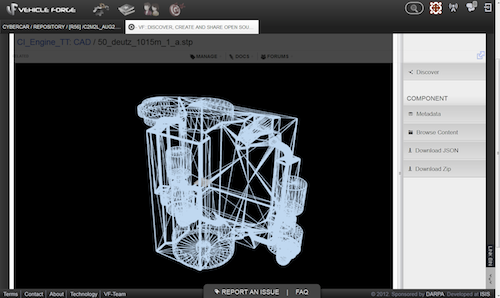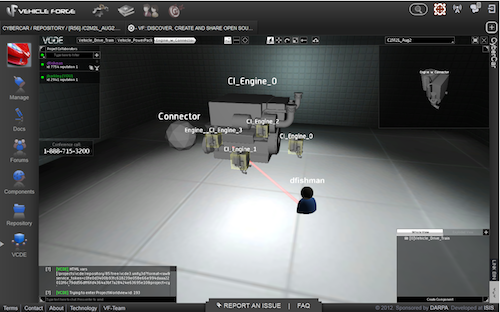Latest News
December 31, 2012
As DARPA gets ready to kick off the first of three FANG (Fast, Adaptable, Next-Generation Ground Vehicle) Challenges next month, the engineering community at large is closer to being able to test drive META, a new set of design tools that promise to fundamentally change the process of complex systems design.
The FANG Challenges, part of DARPA’s Adaptive Vehicle Make (AVM) program, is all about opening up the design process to a wider pool of engineering talent as well as creating a new kind of collaborative design platform that can help eliminate the lengthy and costly design-build-test-redesign cycle that characterizes current development processes for complex military vehicles and systems, according to Army Lieutenant Colonel Nathan Wiedenman, DARPA program manager for the AVM portfolio of programs. “The primary goals of FANG and the practical demonstration of AVM technology development are to raise the level of abstraction in the design process, decouple design and fabrication, and use foundry-style manufacturing to compress the development process timeline by a factor of five,” Wiedenman says.
Currently, only a relatively small number of vendors are able to participate in the design of military systems—a limitation imposed by existing tools that demand the multi-million dollar complex system actually be built first in order to truly understand how it performs. With a crowdsourcing approach and a collaborative tool environment like META, DARPA seeks to connect with engineers and designers beyond the limited landscape of defense contractors, Wiedenman explains, broadening the talent pool it can bring to bear on complex systems design.
META comes into play as a way to shake up the way in which defense systems are engineered. DARPA says while today’s defense vehicles and systems are significantly more complex than they were in the past, they are still designed in much the same manner as they’ve been for the last 50 years. Typically, the design problem is broken down along engineering disciplinary lines based on individual sets of requirements, for the thermal system or the data system, for example. Once the individual components are built, they are put together and tested to see if they work as expected, which invariably, they don’t because components and subsystems interact in ways that can’t be fully anticipated, Wiedenman says. “That means, we have to go back and redesign, rebuild, and retest and so on … it takes a lot of time and a lot of money to iterate like this,” he adds.
In contrast, META will take a “correct-by-construction” approach, which means when the design is complete, the system will work the way the design predicts the first time around, mitigating the costly design-build-test-redesign cycle and opening up the process to a wider set of possible designs. META accomplishes this by exploring the entire tradespace of possible designs from a list of potential system components, Wiedenman says. Participants will prune down the immense set of solutions to a manageable number by applying design constraints and eliminating those with sub-optimal system-level performance.
By allowing for exploration of the entire tradespace, the development process is more open to truly innovative designs that might fall outside of the traditional narrow set of considered options, he explains. Unlike current CAD and CAE tools, which enable model-based engineering in one domain at a time, META will enable the simultaneous analysis of multiple physics domains—geometric, thermal, vibration, fluidic, electro-magnetic, even data.
“The end result is a design that has accomplished all its ‘integration testing’ in a virtual environment to such a degree that the first product built in a factory is a final production model, not a prototype,” Wiedenman says. “This is correct by construction.
META will usher in some novel technology, including the creation of design verification methods for cyber-physical systems, in addition to existing tools like finite element analysis and computational fluid dynamics analysis. It will also enable full complex systems design at multiple levels of abstraction, meaning engineers can assemble designs at any level between the lowest numbered parts to the highest order subsystems.
The META tools will be hosted as part of VehicleFORGE, the collaborative platform built specifically for the FANG Challenges program. VehicleFORGE enables the execution of multiple simultaneous design projects, each of which have version control, version branching, and information assurance controls, and it also includes the Virtual Collaborative Design Environment (VCDE), which enables dispersed design teams to collaborate in a 3D virtual immersive environment with live communications capabilities.
The META design tool suite is currently in beta test and will be available to FANG Challenge participants in mid-January as part of VehicleFORGE. Moving forward, DARPA will make the tools freely available for download as they progress, and it is also funding two commercialization efforts. The first incorporates design verification capabilities into Dassault Systemes’ tool suite, and the second is a cloud-based design capability, named CyDesign Studio, which offers most META functions using the software fee-for-service model, DARPA officials say.
Below is a video describing the FANG Challenges.
Subscribe to our FREE magazine, FREE email newsletters or both!
Latest News
About the Author
Beth Stackpole is a contributing editor to Digital Engineering. Send e-mail about this article to [email protected].
Follow DE







